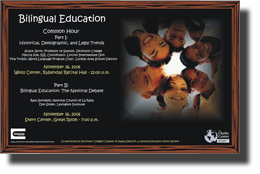Thursday, November 16, 2006
Bilingual Education Symposium
Common Hour
Part I: Historical, Demographic and Legal Trends
Grace Jarvis, Professor of Spanish, Dickinson College
Marcia Kile, ESL Coordinator, LIU
Tina Trozzo, World Languard Program Chair, CASD
Weiss Center, Rubendall Recital Hall, 12:00 pm
Part II: The National Debate
Raul Gonzalez, National Council of La Raza
Don Soifer, Lexington Institute
Stern Center, Great Room, 7:00 pm

Issue in Context
Started in 1968 by the federal government, bilingual education programs are designed to educate students whose first language is one other than English. The goal of these programs is to help students become proficient in English and be able to succeed in mainstream classes. The nation’s schools are becoming increasingly diverse in all areas, both urban and rural, further emphasizing the need for bilingual educators. Over the last decade the number of students in the United States in need of bilingual education has increased to three million. These changing demographics are demanding more effective bilingual education programs nationwide.
The best method of bilingual education has been highly debated for years. The major issue is the extent to which the student’s native language should be used. Some educators are proponents of instruction in the native language before instruction in English, while others believe that full immersion in the English language with little use of the native language yields the best results. The three most common instructional methods include Immersion Programs using English instruction and the native language only when necessary, Developmental Bilingual Education aiming to perfect skills in the native language while learning English, and Transitional Bilingual Education providing students with academic instruction in their native language as well as English language instruction during the course of the day. It is the goal of all bilingual educators to find the most effective and efficient method of teaching students for whom English is a second language.
About the Speakers
Marcia Kile has been working as a program consultant for the Migrant Programs and ESL Services at the Lincoln Intermediate Unit No. 12 for over two decades. She is a member of several organizations including U.S. Representative William Goodling’s Education Advisory Committee, Alliance for Cultural Equity and the Pennsylvania Alliance for ESL Certification. Ms. Kile has significant experience with English as a second language as well as multicultural education.
Tina Trozzo has worked for 26 years in the Carlisle Area School District ; she is the head of the ESL and World Language Department. Ms. Trozzo is certified in ESL, English and Spanish.
Grace Jarvis is the chair of the Spanish department at Dickinson College. Professor Jarvis coordinates and teaches introductory courses in Spanish as well as supervises activities sponsored by the department. Her interests include multi-lingual, multicultural and international education.
Raul Gonzalez works as the Legislative Director for the National Council of La Raza. His work centers on education policy and he collaborates with the Bush Administration, advocacy groups and Congress to improve education options for Latino Americans.
Don Soifer serves as the executive vice president of the Lexington Institute, located near Washington , D.C. His work has appeared in The Wall Street Journal and many other publications nationwide. Soifer has acted as a consultant for the Virginia Department of Education and has testified before state legislatures and Congress on bilingual education.
Related Links
National Association for Bilingual Education
National Council of La Raza
Kappa Delta Pi, Honor Society for Education
Lexington Institute-Education
